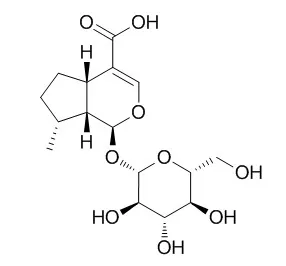| Description: |
8-Epideoxyloganic acid possesses bioactivities of analgesia, homeostasis and anti-inflammatory. It has the potential to serve as anti-inflammatory agents during oxidative stress, the inhibition of ROS production, possibly through modulation of NOX activity and/or the radical scavenging effect, and beta2 integrin expression in leucocytes. 8-Epideoxyloganic acid (oral) shows weak antinociceptive activity. |
| Targets: |
Immunology & Inflammation related | ROS |
| In vitro: |
| J Pharm Pharmacol. 2006 Jan;58(1):129-35. | | The inhibitory effect of phenylpropanoid glycosides and iridoid glucosides on free radical production and beta2 integrin expression in human leucocytes.[Pubmed: 16393473 ] | Rapid production of reactive oxygen species (ROS) and upregulation of beta2 integrin by leucocytes are two important inflammatory responses in human leucocytes.
METHODS AND RESULTS:
To evaluate whether three phenylpropanoid glycosides (acteoside, crenatoside, and rossicaside B) and two iridoid glucosides (boschnaloside and 8-Epideoxyloganic acid) identified from two medicinal plants with similar indications (Orobanche caerulescens and Boschniakia rossica) exhibited anti-inflammatory activity, their effects on N-formyl-methionyl-leucyl-phenylalanine (fMLP) and phorbol-12-myristate-13-acetate (PMA)-activated peripheral human neutrophils (PMNs) and mononuclear cells were examined. Furthermore, all compounds, except rossicaside B, significantly inhibited PMA- and fMLP-induced Mac-1 (a beta2 integrin) upregulation at 50 microM but not that of fMLP-induced intracellular calcium mobilization. These drugs had no significant cytotoxicity as compared with the vehicle control.
CONCLUSIONS:
Our data suggested that inhibition of ROS production, possibly through modulation of NOX activity and/or the radical scavenging effect, and beta2 integrin expression in leucocytes indicated that these compounds had the potential to serve as anti-inflammatory agents during oxidative stress. |
|
| In vivo: |
| Phytochemistry. 2000 Jan;53(2):253-6. | | Antinociceptive substances from Incarvillea delavayi.[Pubmed: 10680179] | Antinociceptive activities of an Incarvillea delavayi extract, as well as its constituents, 8-Epideoxyloganic acid and delavayine A, were evaluated in the acetic acid induced writhing test in mice.
METHODS AND RESULTS:
An oral administration of the delavayi extract weakly decreased the number of writhings and stretchings in this test, in a dose-dependent manner. Furthermore, orally administered 8-Epideoxyloganic acid showed weak antinociceptive activity, whereas administration by subcutaneous injection did not. However, subcutaneous injection of delavayine A, a novel monoterpene alkaloid, showed a more significant level of antinociceptive activity. | | Zhongguo Zhong Yao Za Zhi. 2011 Feb;36(4):465-7. | | Constituents and bioactivities of Lamiophlomis rotata.[Pubmed: 21598543] | To investigate the chemical constituents from Lamiophlomis rotata and the bioactivities of 8-Epideoxyloganic acid.
METHODS AND RESULTS:
The constituents were isolated by using a combination of various chromatographic techniques including column chromatography over ployamide, silica gel and Sephadex LH-20. Structures of the isolates were identified by spectroscopic data analysis. Bioactivities were screened by using models in vivo. Five constituents were isolated. 8-Epideoxyloganic acid was isolated for the first time in L. rotata and also in lamioplomis genus.
8-Epideoxyloganic acid could significantly inhibit aectic acid-induced twisting times and slower the time of homeostatsis, also inhibit xylene-induced ear edema in mice.
CONCLUSIONS:
8-Epideoxyloganic acid possesses bioactivities of analgesia, homeostasis and anti-inflammatory. |
|






 Cell. 2018 Jan 11;172(1-2):249-261.e12. doi: 10.1016/j.cell.2017.12.019.IF=36.216(2019)
Cell. 2018 Jan 11;172(1-2):249-261.e12. doi: 10.1016/j.cell.2017.12.019.IF=36.216(2019) Cell Metab. 2020 Mar 3;31(3):534-548.e5. doi: 10.1016/j.cmet.2020.01.002.IF=22.415(2019)
Cell Metab. 2020 Mar 3;31(3):534-548.e5. doi: 10.1016/j.cmet.2020.01.002.IF=22.415(2019) Mol Cell. 2017 Nov 16;68(4):673-685.e6. doi: 10.1016/j.molcel.2017.10.022.IF=14.548(2019)
Mol Cell. 2017 Nov 16;68(4):673-685.e6. doi: 10.1016/j.molcel.2017.10.022.IF=14.548(2019)